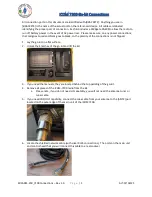
Section 8
Glossary
Page 8 - 2
EchoStar D-2400IP
©
2
001
E
c
hoS
tar
Inte
rnati
o
nal
C
o
rp
orat
io
n
A
ll
rig
hts
re
s
erved
2.
EXPLANATION OF USED TERMINOLOGY
C-band
A frequency range (3.70-4.20 GHz) used for satellite
broadcasts.
CCITT
An European committee of the international
Telecommunications Union and makes recommendations for
the distribution of telephone and data distribution.
Clarke Belt
The Clarke Belt is a dedicated satellite orbit in which
satellites remain in a fixed position relative to the Earth’s
surface.
CI-module/CAM
Both names are used for these modules. These modules are
PCMCIA cards with a slot in which you can insert a smart
card.
Common Interface (CI)
A DVB standard which defines the software and hardware
requirements for condition access systems.
Conditional Access
A system which is used by service providers to control the
subscriber’s access to certain services, programs and events
like Pay TV.
DBS band
A signal frequency range (11.70-12.40ghz) intended for
direct TV broadcast by satellite channels.
Decoder
A unit that is connected to a satellite receiver in order to
unscramble a picture that is protected by encryption.
Digital Audio Broadcasting
Standard which describes the method of transmitting digital
audio.
DiSEqC
A standard through which it is possible to let a DiSEqC
compatible receiver send a signal over the RF cable to a
switching device to switch between different LNBs or dishes.
The DiSEqC uses the 22 kHz signal to control the switching
device.
DVB
A broadcast standard for digital radio and television, using
MPEG-2 compression. DVB is being supported by all
European manufacturers and broadcasters.
EPG
A electronic program guide that comes with the broadcast of
a particular satellite, Note that every station fills the EPG
differently or not, so differences in the EPG are not
necessarily receiver errors.
FEC
Is an invisible part of a broadcast which makes sure that
possible errors in the reception of the satellite signal are
corrected.
Feedhorn
A part of the dish which collects the signals from the dish.
The signal is then fed to the LNB(F).
Ferrite
A remote controlled device that determines the polarity of the
signal which is fed to the LNB. The ferrite is more or less an
electro-magnetic polarizer.
Fixed Dish
A dish antenna that is pointed at one particular satellite.
Free-To-Air broadcast
An unscrambled broadcast which you can view without
additional payments to a service provider.
Frequency band
A frequency band is a range of frequencies which are
dedicated to a certain usage. In the satellite area, commonly
known bands are the C-band and the Ku-band.
High Definition Television
A digital television format, which combines high-resolution
video and theater like sound to create a movie theater quality
TV viewing experience.
Horizontal
In the satellite industry, horizontal is used to indicate the
direction in which the received signal is polarized. Normally
you will find that it is abbreviated as H.
KU-band
A frequency range (10.70-18.00 GHz) used by most
European TV satellites.
LNB
A device behind the feedhorn which processes the signal
into a format which is understood by the receiver for further
processing
Содержание D-2400 IP
Страница 1: ...USER MANUAL D 2400IP Digital Satellite Receiver Printed on recycled paper ...
Страница 54: ...Section 5 Operation Page 5 16 EchoStar D 2400IP 2002 EchoStar International Corporation All rights reserved ...
Страница 62: ...Section 6 Maintenance Page 6 8 EchoStar D 2400IP 2002 EchoStar International Corporation All rights reserved ...
















































